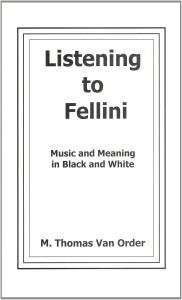On a related topic:
Contemporary Italian Filmmaking (1995)
Strategies of Subversion : Pirandello, Fellini, Scola, and the Directors of the New Generation
Federico Fellini (2025)
Centenary Essays
Dir. Marco Malvestio, Jessica Whitehead and Alberto Zambenedetti
Subject: Director > Federico Fellini
The Dream of Life (2022)
A Novel Based on the Life of Federico Fellini
by Kate Fuglei
Subject: Director > Federico Fellini
Fellini's Films and Commercials (2020)
From Postwar to Postmodern
by Frank Burke
Subject: Director > Federico Fellini
Political Fellini (2018)
Journey to the End of Italy
by Andrea Minuz
Subject: Director > Federico Fellini
Inspiring Fellini (2014)
Literary Collaborations behind the Scenes
Subject: Director > Federico Fellini
Federico Fellini (2013)
Painting in Film, Painting on Film
by Hava Aldouby
Subject: Director > Federico Fellini
Federico Fellini (2002)
Contemporary Perspectives
Dir. Francis Burke and Marguerite R. Waller
Subject: Director > Federico Fellini
Listening to Fellini
Music and Meaning in Black and White


Average rating: ![]()
| 0 | rating | |
| 0 | rating | |
| 0 | rating | |
| 0 | rating |
Your rating: -
Book Presentation:
For decades scholarship on Federico Fellini has focused on the figure of the director himself, while formal analysis based on the craft of filmmaking has been largely ignored. Fellini spent countless hours in the studios of Cinecitta recording, mixing, and editing music, voices, and sound effects for his films, but his unique and often revolutionary uses of cinematic sound have never been systematically studied. This book reveals the singularly important role played by music in the construction of meaning in Fellini's black and white feature-length films, and presents a substantial re-reading of the seven films made during the most creative period of Fellini's artistic development: The White Sheik, I vitellini, La strada, Il bidone, The Nights if Cabiria, La dolce vita, and 8 1/2.
The editing of music in Fellini's first films represents an entirely new approach to cinematic sound. The sophistication and complexity of Fellini's soundtracks far surpasses the neorealist models that are often assumed to form the practical foundation of Fellini's earliest works, and an analysis of the editing of music in these films reveals extraordinary innovation in the pairing of music and visual image. Although these films may often seem visually conventional, the soundtracks- characterized by abrupt cuts, comic synchronization with the visual image, unrealistic passages between nondiegetic and diegetic musical sources, and the coexistence of diegetic sources with nondiegetic musical accompaniment- undermine the verisimilitude of the projected image, facilitate aesthetic distance, and emphasize artifice at the expense of 'reality.' Functioning as an ironic, often dissonant counterpoint to the narrative structure of the visual images, the manifestly artificial editing of music in Fellini's films questions the verisimilitude of cinematic narration by revealing the interpenetratin of representation and reception, being and seeming, history and story, 'truth' and fiction.
About the Author:
M. Thomas Van Order is assistant professor in Italian at Middlebury College.
Press Reviews:
'This is, without question, one of the most important works on Fellini in the last several decades, and unquestionably the most original. It is absolutely fundamental. It will have to be cited and used by anyone who writes about Fellini or teaches him' -- Ben Lawton, Chair Film/Video Studies, Purdue Unviersity
See the publisher website: Fairleigh Dickinson University Press
See the complete filmography of Federico Fellini on the website: IMDB ...